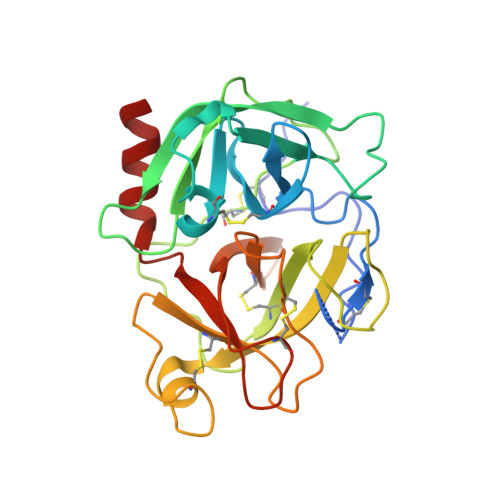X-ray crystal structure of plasmin with tranexamic acid-derived active site inhibitors.
Law, R.H.P., Wu, G., Leung, E.W.W., Hidaka, K., Quek, A.J., Caradoc-Davies, T.T., Jeevarajah, D., Conroy, P.J., Kirby, N.M., Norton, R.S., Tsuda, Y., Whisstock, J.C.(2017) Blood Adv 1: 766-771
- PubMed: 29296720
- DOI: https://doi.org/10.1182/bloodadvances.2016004150
- Primary Citation of Related Structures:
5UGD, 5UGG - PubMed Abstract:
The zymogen protease plasminogen and its active form plasmin perform key roles in blood clot dissolution, tissue remodeling, cell migration, and bacterial pathogenesis. Dysregulation of the plasminogen/plasmin system results in life-threatening hemorrhagic disorders or thrombotic vascular occlusion. Accordingly, inhibitors of this system are clinically important. Currently, tranexamic acid (TXA), a molecule that prevents plasminogen activation through blocking recruitment to target substrates, is the most widely used inhibitor for the plasminogen/plasmin system in therapeutics. However, TXA lacks efficacy on the active form of plasmin. Thus, there is a need to develop specific inhibitors that target the protease active site. Here we report the crystal structures of plasmin in complex with the novel YO ( trans -4-aminomethylcyclohexanecarbonyl-l-tyrosine- n -octylamide) class of small molecule inhibitors. We found that these inhibitors form key interactions with the S1 and S3' subsites of the catalytic cleft. Here, the TXA moiety of the YO compounds inserts into the primary (S1) specificity pocket, suggesting that TXA itself may function as a weak plasmin inhibitor, a hypothesis supported by subsequent biochemical and biophysical analyses. Mutational studies reveal that F587 of the S' subsite plays a key role in mediating the inhibitor interaction. Taken together, these data provide a foundation for the future development of small molecule inhibitors to specifically regulate plasmin function in a range of diseases and disorders.
- Department of Biochemistry and Molecular Biology and.
Organizational Affiliation:

















